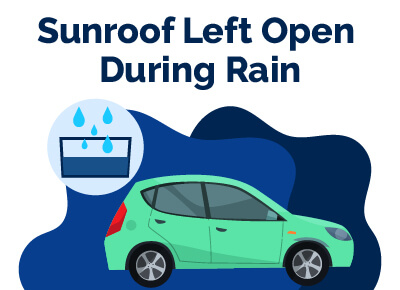Sunroof Left Open in the Rain (What To Do About It)
July 25, 2023


Chris is Head of Content for FindTheBestCarPrice and is based out of Philadelphia, PA. As a seasoned automotive industry analyst and car enthusiast, he ensures the highest level of quality across all our content and curates our picks for the best deals each month.
Chris studied information systems and marketing at Drexel University and writes about a wide range of topics ranging from car buying tips to troubleshooting common mechanical issues.
When he’s not thinking about cars, he likes to stay in with his dog and make an “attempt” to finish a crossword puzzle (he’s not quite at the Saturday/Sunday level…yet). As a former cheesemonger, Chris still has a “sharp” passion for all things cheese, and his fridge is always loaded with it!
Chris also has a passion for things that go fast, and drones are no exception. He spends some of his time writing for Dronesourced.
Leaving your sunroof open during a rainstorm can be a frustrating and potentially damaging mistake. Even a small amount of rainwater can cause damage to your car's interior, including upholstery, electronics, and carpeting.
In addition to the risk of damage, leaving your sunroof open in the rain can pose a safety risk, as water can obstruct your vision and make driving difficult.
Let’s explore the potential consequences of leaving your sunroof open in the rain, including the impact on your car's interior and safety. We will also provide tips on preventing water damage and what steps you can take if your car's interior has already been affected.
Whether you're a newbie driver or an expert, you will learn more about dealing with a sunroof left open in the rain.
Let’s get started!
Table of Contents
What Happens When the Sunroof Is Left Open in the Rain?
Mild issues stemming from prolonged exposure of your vehicle to water, mainly rainwater with high acid concentration, can manifest as unpleasant odors, mold growth, interior deterioration, or rusting of metal components.
As water infiltrates various vehicle parts over time, more severe consequences may arise, including hazardous electrical faults and equipment malfunction. They include the following:
1. Hydrolock
The dreaded hydro lock phenomenon is a grave concern for many drivers, as it can result in significant damage to the engine that requires substantial time and financial resources to repair.
This occurs when water infiltrates the combustion chamber of the engine's cylinder, impeding the piston's movement and preventing fuel combustion.
As a result, the engine stalls, and attempting to restart it without realizing the issue can exacerbate the damage.
The pistons pushed up for air compression collide with the force of water, resulting in the deformation of the connecting rods.
In more severe cases, the cylinder wall may be scratched, or the connecting rod may break, resulting in a punctured cylinder wall and a halted engine.
One telltale sign of a damaged cylinder is a sudden drop in the coolant level.
However, this risk is more prevalent when the vehicle is frequently driven through deeply flooded areas, while rainwater seeping through the sunroof is unlikely to cause such catastrophic damage.
2. Electrical Issues
Without a doubt, the electrical system, which serves as the lifeblood of most modern engines, is exceptionally vulnerable to damage when exposed to water infiltration in vehicles.
Even a minor issue with the electrical system can result in many problems, ranging from delayed or malfunctioning headlights, turn signals, interior lights, dashboards, air conditioning systems, speaker and radio systems, navigation systems, and more, to complete devastation of these components.
Even after the vehicle is removed from the water, the electrical wiring and plugs near the body and center console may remain saturated, posing the risks of electric shock or hazardous fires.
In specific scenarios, the vehicular electrical system may experience an abrupt cessation of functionality while the vehicle is in motion, thereby compounding the hazards and intricacies of the situation.
In order to effectively mitigate the peril of potentially fatal electrical shocks, it is imperative to exercise utmost caution and abstain from any physical contact or interaction with electrical components until they have undergone thorough drying and have been unequivocally deemed safe for handling.
3. Rust
Numerous metal components are incorporated into the intricate design of an automobile.
However, acid's corrosive nature in rainwater can swiftly trigger rust formation on these vulnerable parts.
It is crucial to meticulously inspect and monitor various aspects such as screws, bolt holes, bolt heads, thread starters, and any other structural linkages within the vehicle for signs of rust.
The insidious effects of rust can significantly diminish the vehicle's interior's lifespan, durability, bearing capacity, hygiene, and aesthetic appeal.
Thus, preemptive measures must be taken to safeguard against this deleterious corrosion.
What To Do If Sunroof Is Left Open in the Rain
The cabinet requires adequate ventilation; thus, the sunroof is frequently left ajar. Unfortunately, an unexpected downpour occurs due to an oversight, leaving you regretful for not closing the roof window.
As a consequence, the interior of your vehicle becomes saturated, damp, and susceptible to damage. The repercussions can be detrimental if you unintentionally leave your sunroof open during a rainstorm.
The following are steps you can take to mitigate the damage done to your vehicle as a result of the rain:
1. Get Rid of as Much Water as You Can
Efficiently removing accumulated water from your vehicle is imperative. Utilize a wet/dry vacuum to extract any standing water pooling around the floorboards, paying attention to the crevices between the seats, center console, and armrests.
Water may also flow down slopes and collect at the lowest point of the vehicle. Some cars are equipped with removable floor drain plugs that can be extracted to facilitate drainage.
Removing drain plugs may require effort, depending on the vehicle's design. Once the seats and carpets are thoroughly cleaned, employ cloth towels instead of paper towels due to their superior absorbency and reusability, which minimizes waste.
Ensure the cloth towels are firmly pressed into the carpet and seats to absorb moisture from beneath the surface.
If you removed floor drain plugs, reposition them correctly, and seal them with the appropriate sealant if needed, depending on the material.
2. Utilize Air Flow To Get Rid of More Moisture
Even with thorough toweling and vacuuming, your car's fabric, carpeting, and chassis may still feel damp, leaving lingering moisture.
To address this issue, the initial step is strategically positioning one or two fans, creating airflow across the car's floors and seats. Utilizing a shop fan would be optimal for this purpose, as nothing surpasses the power of airflow.
A plug-in leaf blower can generate air power underneath the seats for added efficacy.
Running your garage's fans for at least a day after opening the car's doors is recommended to ensure complete drying of any residual moisture.
In the garage, placing a dehumidifier alongside the running fans can further aid in drying the air to the fullest extent possible.
If you are away from home, you can mimic the drying effect of fans by activating your car's heater. Turn on the air conditioner, set the temperature to hot, increase the fan speed to high, and enable recirculation mode.
Heater boxes in cars are equipped with evaporators that collect moisture from recirculated heated air, which is drained out.
Although this method may be less effective, it can serve as a temporary solution until a proper ventilation system can be established.
Despite diligently following the steps above, stubborn moisture may persist, breeding mold growth and musty odors.
In such cases, a blow dryer can prove to be more effective than mere air fresheners, especially for areas that continue to feel damp.
To further mitigate the risk of unpleasant odors permeating your car's cabin, it is advisable to place moisture-absorbent products, such as baking soda or dehumidifier packs, behind each seat.
These measures can significantly reduce the likelihood of undesirable odors taking root in your vehicle over time.
However, it is crucial to ventilate your car whenever possible while keeping a vigilant eye on the weather forecast to avoid being caught in a similar predicament again.
Rest assured, you don't need to fret if your car gets wet. Maintaining a composed demeanor and diligently following these steps to thoroughly dry the interior can protect your vehicle from permanent water damage.
3. Do Not Turn on the Engine
The ingress of rainwater into the engine can cause profound damage if the vehicle is restarted, as it can allow water to seep even deeper into delicate components.
Unintentional engine restarting must be avoided to prevent irreparable harm and ensure a smooth recovery process.
If the driver wishes to change speed or halt the car's motion, shifting the transmission to position N (Neutral) is imperative.
Furthermore, to prevent any hazardous electric leakage, removing the battery pile after turning off the ignition, opening the bonnet, and extracting the battery pile is crucial.
To safeguard against electric shocks during this procedure, it is highly recommended to don specialized gloves and footwear for additional protection.
As a final precautionary measure, entrusting the transportation of the vehicle to service for immediate transfer to a repair garage can facilitate the early detection and resolution of any potential complex issues.
Installing a smart sensor device on the windshield wiper can be a viable solution to avert such incidents' recurrence.
This cutting-edge technology can effectively detect rain or snow and automatically close the sunroof to prevent water intrusion.
It should be noted that the following tips are primarily applicable to freshwater resulting from rain or snow.
In cases where the vehicle has been flooded or submerged in deep water, more comprehensive measures may be necessary beyond simple drying to mitigate potential damages.
4. Let There Be Proper Ventilation
If you leave your car's sunroof open in the rain, it is imperative to dry it to prevent moisture accumulation.
To ensure your car receives ample sunlight, lowering the windows and opening the doors is crucial, allowing sunlight to permeate the interior.
In cases where the parking area lacks sufficient sunlight, utilizing battery-operated or electric fans can be a prudent solution.
These fans can effectively eliminate musty odors, mildew, and mold growth, helping maintain a clean environment inside your vehicle.
Best Car Deals by Category
Posted in Car Buying Tips, Car Troubleshooting |




